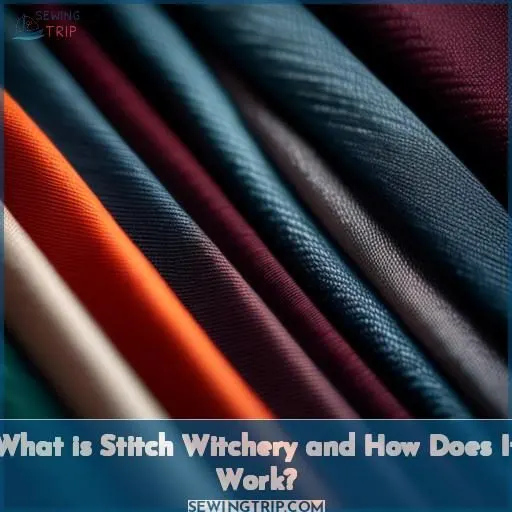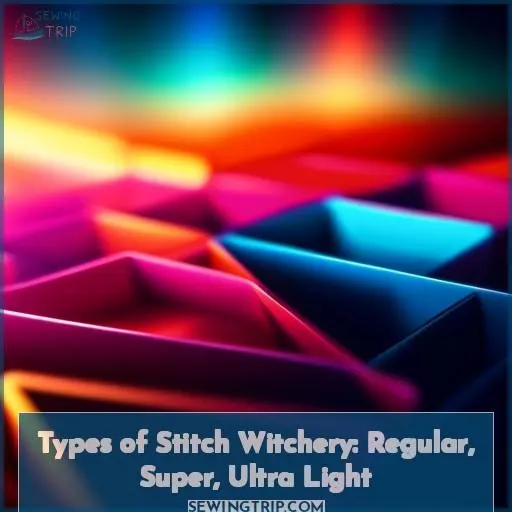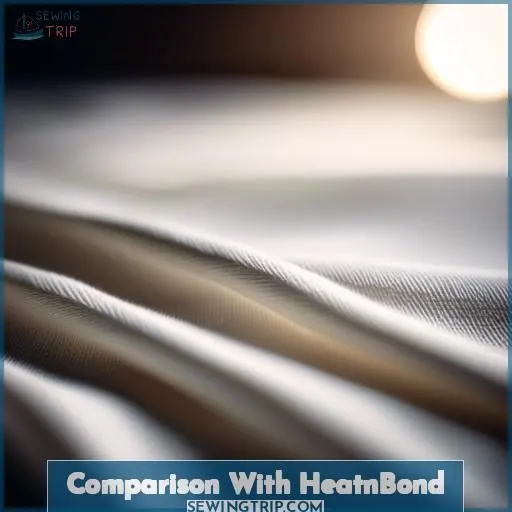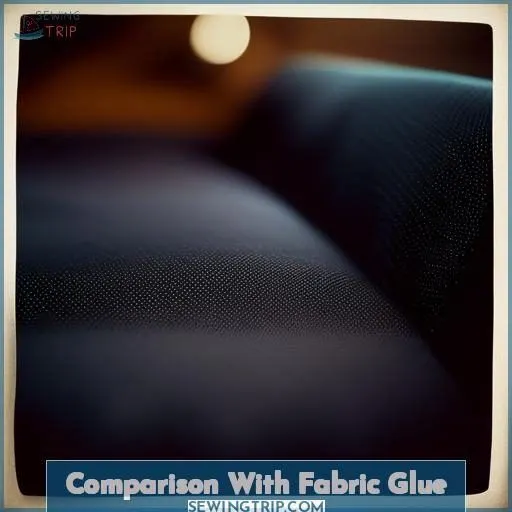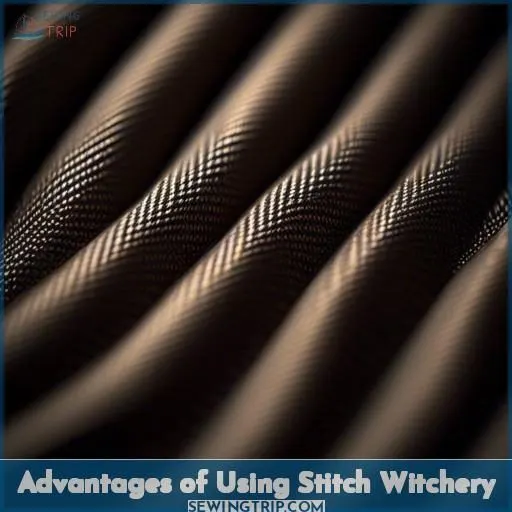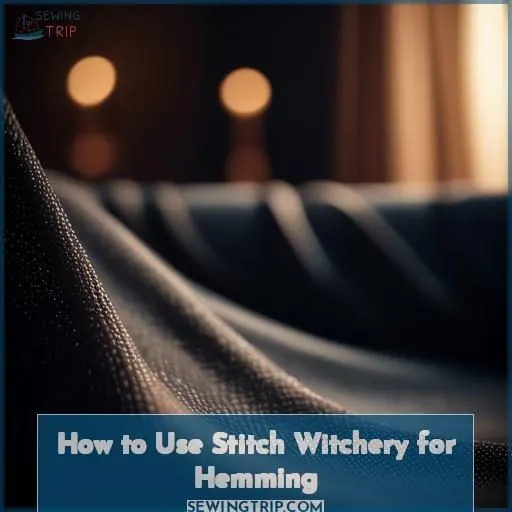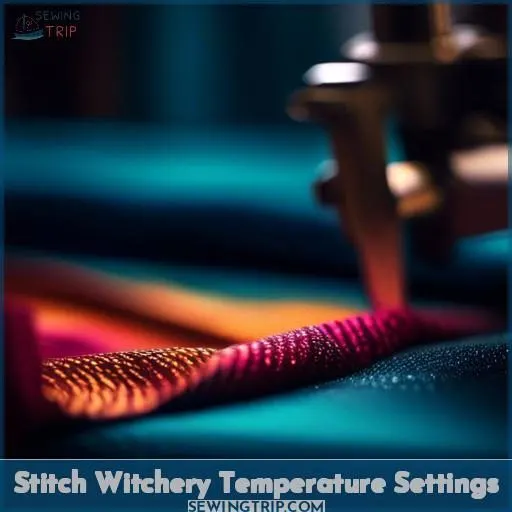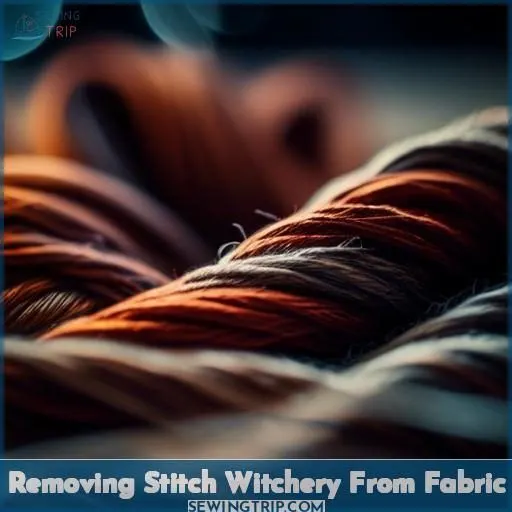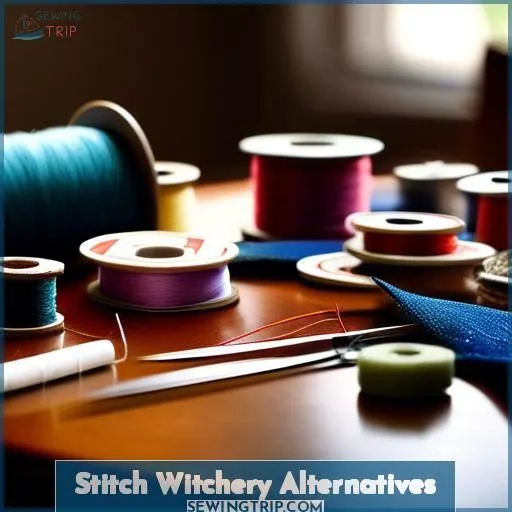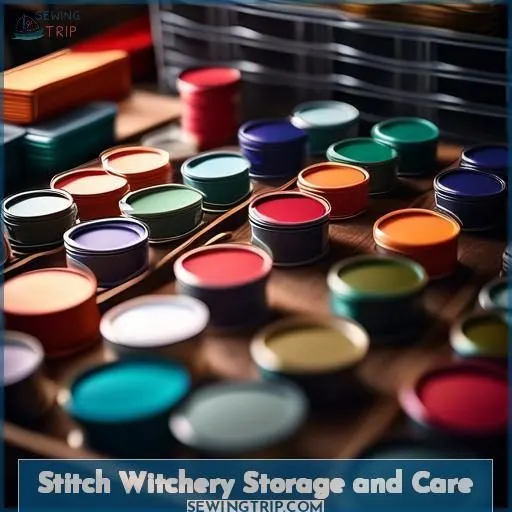This site is supported by our readers. We may earn a commission, at no cost to you, if you purchase through links.
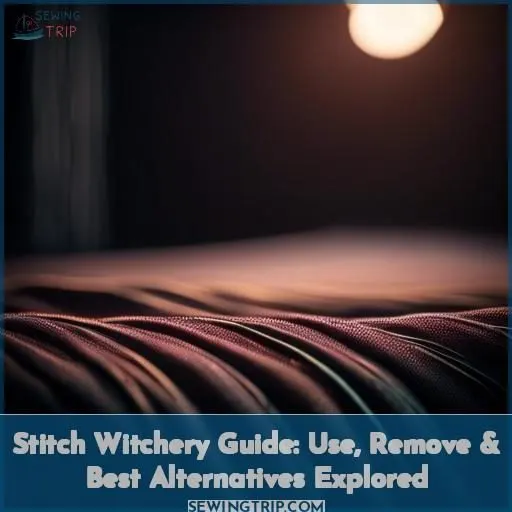
Stitch Witchery is a permanent adhesive that forms a strong, long-lasting bond when applied to fabric. Once heated, the adhesive becomes invisible, creating an indiscernible, perpetual bond. The bond is durable and virtually invisible, making it ideal for various uses, including hemming, trims, and appliques.
The adhesive is available in three weights: Regular, Super, and Ultra Light, suitable for different fabrics. Stitch Witchery is more flexible than other adhesives like HeatnBond, preserving the fabric’s natural flow.
If you’re interested in learning more about Stitch Witchery, including how to use it, remove it, and find alternatives, continue reading.
Table Of Contents
- Key Takeaways
- Is Stitch Witchery Permanent?
- What is Stitch Witchery and How Does It Work?
- Types of Stitch Witchery: Regular, Super, Ultra Light
- Comparison With HeatnBond
- Comparison With Fabric Glue
- Advantages of Using Stitch Witchery
- How to Use Stitch Witchery for Hemming
- Stitch Witchery Temperature Settings
- Removing Stitch Witchery From Fabric
- Stitch Witchery Alternatives
- Stitch Witchery Storage and Care
- Frequently Asked Questions (FAQs)
- Conclusion
Key Takeaways
- Stitch Witchery is a permanent adhesive that forms a strong, long-lasting bond when applied to fabric.
- It becomes invisible once heated, creating an indiscernible, permanent bond.
- The bond is durable and virtually invisible, making it ideal for various uses, including hemming, trims, and appliqués.
- Stitch Witchery is available in three weights: Regular, Super, and Ultra Light, suitable for different fabrics.
Is Stitch Witchery Permanent?
Yes, Stitch Witchery is generally permanent. It works by bonding the fibers of your fabric together, effectively sewing the fabric together.
What is Stitch Witchery and How Does It Work?
Stitch Witchery is a fusible adhesive that revolutionizes hemming, trims, and appliques in sewing. It’s a double-sided, heat-activated synthetic material that bonds fabric when exposed to heat, making it invisible once applied. This no-sew solution is perfect for a variety of projects and materials.
When compared to other adhesives like HeatnBond, Stitch Witchery has a different appearance and can be stiffer or bulkier on hems. It may not bond all materials and isn’t suitable for lightweight fabrics. HeatnBond requires an iron for use.
In contrast to fabric glue, Stitch Witchery is less messy and holds up better under wear and tear. However, it may create wrinkles or imperfections and isn’t suitable for attaching small items or certain materials. Like Stitch Witchery, fabric glue also requires an iron for use.
Stitch Witchery is a permanent bonding web and is available in three weights: Regular, Super, and Ultra Light. The Regular weight is suitable for medium fabrics, Super for heavier fabrics, and Ultra Light for delicate fabrics. It comes in various widths for different hem sizes.
Stitch Witchery is a versatile and convenient tool for sewing enthusiasts. It’s a must-have in any sewing kit and can be used for a variety of projects, including hemming, trimming, and applique. To use Stitch Witchery, simply cut a strip to your desired length, place it between fabric pieces, press with an iron for 30-60 seconds, allow it to cool for 1-2 minutes, and test on a scrap fabric first.
Types of Stitch Witchery: Regular, Super, Ultra Light
Stitch Witchery is a versatile adhesive that comes in three different weights: Regular, Super, and Ultra Light. The Regular weight is suitable for medium fabrics, while the Super weight is ideal for heavier fabrics. The Ultra Light weight is designed for lightweight fabrics and is perfect for bonding materials that require a lighter bonding web.
Dritz Stitch Witchery is the most popular brand, offering a range of weights and widths to cater to various hem sizes. When choosing the right weight for your project, consider the fabric’s weight and the desired bonding strength. Regular weight Stitch Witchery is a go-to for many seamstresses, as it provides a strong bond without being too stiff or bulky on the hem.
Comparison With HeatnBond
Shifting gears from the versatile Stitch Witchery, let’s explore its comparison with HeatnBond. While both serve as iron-on adhesives, they’re not quite cut from the same mold. HeatnBond, often the go-to for weighty fabrics, can sometimes leave you in a tricky situation when applied to light materials, resulting in stiffness that could rival a board meeting.
On the other hand, Stitch Witchery preserves the fabric’s natural flow, making it a smoother operator for delicate projects. The pros and cons are clear: if you’re aiming for flexibility without the rigidity, Stitch Witchery comes out on top. However, for projects requiring a firmer hand, HeatnBond might just have the upper hand.
Comparison With Fabric Glue
Stitch Witchery and fabric glue are both common adhesives employed in fabric crafts, but they exhibit distinct disparities. While Stitch Witchery is a heat-actuated, double-sided synthetic substance that fuses fabric upon exposure to heat, fabric glue is a disjointed, occasionally enduring adhesive that necessitates the utilization of an iron.
Fabric glue can be rigid and voluminous on hems, may not adhere to all materials, and can engender wrinkles or blemishes. Conversely, Stitch Witchery is indiscernible once applied, and its bond is perpetual. However, Stitch Witchery removal can be formidable.
If you seek cost-free alternatives, ponder using Wonder Tape for securing zippers and fabrics that tend to evade adherence or venture into the realm of experimenting with diverse adhesives for specific undertakings. Invariably adhere to the directives provided by the manufacturer to attain the most favorable outcomes.
Advantages of Using Stitch Witchery
Stitch witchery, also known as Dritz Stitch Witchery, is a popular option for sewers and crafters due to its many benefits. Here are three reasons why you might want to contemplate using stitch witchery for your next project:
- Versatility: Stitch witchery can be used for a variety of tasks, including hemming, trims, and appliques. It’s suitable for a range of fabrics, from medium to heavyweight, and comes in different widths to cater to various hem sizes.
- Durability: Once applied, stitch witchery is virtually invisible. It bonds fabric when exposed to heat, creating a strong and long-lasting bond. This makes it ideal for permanent fusing and covering up mistakes.
- Time-saving: Stitch witchery is easy to use and can save you time compared to other methods. You simply cut a strip to the desired length, place it between fabric pieces, and press with an iron for 30-60 seconds. After cooling for 1-2 minutes, you can test the bond on a scrap fabric first.
How to Use Stitch Witchery for Hemming
To use Stitch Witchery for hemming, follow these steps:
- Choose the right weight: Select the appropriate weight of Stitch Witchery based on the fabric type. Regular weight is suitable for medium fabrics, while super weight is for heavier fabrics.
- Cut the strip: Measure and cut a strip of Stitch Witchery to the desired length for your hem.
- Place between fabric pieces: Position the Stitch Witchery between the two layers of fabric, making sure it doesn’t stick out from the top of the hem.
- Press with an iron: Apply heat to the Stitch Witchery using an iron for 30-60 seconds.
- Allow to cool: Wait for 1-2 minutes after pressing to allow the Stitch Witchery to cool and bond the fabric.
- Test on scrap fabric: Before using Stitch Witchery on your project, test it on a scrap piece of fabric to make sure it works well with your fabric type.
Stitch Witchery Temperature Settings
For successful hemming with Stitch Witchery, selecting the appropriate ironing temperature is vital. The recommended settings vary according to the fabric weight and the specific Stitch Witchery product employed. Refer to this table for guidance:
| Stitch Witchery Weight | Fabric Protection | Heat Tolerance | Bonding Strength | Application Methods |
|---|---|---|---|---|
| Ultra Light | Delicate fabrics | Minimal | Minimal | Iron application |
| Regular (Medium) | Moderate fabrics | Moderate | Moderate | Iron application |
| Super | Robust fabrics | High | High | Iron application |
For Ultra Light Stitch Witchery, a low temperature is advised to prevent fabric damage. Regular and Super weights can tolerate moderate to high heat, but starting with a lower setting and adjusting as necessary is prudent. Utilizing a moistened pressing cloth can safeguard delicate fabrics during ironing.
Removing Stitch Witchery From Fabric
Concerning the removal of Stitch Witchery from fabric, there are several approaches you can utilize. Here are four of the most effective techniques:
- Heat Application: Apply heat to the adhesive using a heated iron. The heat will cause the adhesive to soften, facilitating its removal.
- Adhesive Alternatives: Consider using a different type of adhesive, such as a fabric glue stick, which can be easier to remove.
- Fabric Considerations: The type of fabric can impact the ease with which Stitch Witchery can be removed. For instance, thicker fabrics may pose more difficulty.
- Recommended Practices: Always test the removal technique on a spare piece of fabric first to confirm that it won’t harm the fabric.
Stitch Witchery Alternatives
After addressing the sticky dilemma of removing Stitch Witchery from fabric, let’s explore the realm of its counterparts. Your pursuit of expertise demands familiarity with your armamentarium.
- HeatnBond vs Stitch Witchery: HeatnBond may exhibit reluctance with delicate fabrics, yet it emerges as a formidable adversary for robust materials.
- Fabric Glue vs Stitch Witchery: Fabric glue can be a somewhat untidy companion, but it adheres steadfastly through adversity.
- Starch vs Stitch Witchery: Starch serves as the ethereal, unconstrained solution for fleeting repairs.
- Wonder Tape vs Stitch Witchery: Wonder Tape reigns supreme as your ephemeral ally, particularly suitable for zippers and evasive fabrics.
- Steam-a-Seam: This alternative embodies Stitch Witchery’s kindred spirit, possessing versatility but demanding a deeper commitment.
Make a judicious selection, and may your textile endeavors be seamless and unblemished!
Stitch Witchery Storage and Care
Stitch Witchery is a versatile fabric adhesive that can be stored for a long time, but it’s vital to follow proper storage recommendations to maintain its stickiness and shelf life. Here are some best practices for storing and caring for your Stitch Witchery:
- Humidity Considerations: Keep Stitch Witchery in a dry, cool place to prevent moisture buildup. High humidity can cause the adhesive to lose its stickiness over time.
- Shelf Life: Stitch Witchery has a shelf life of about 2-3 years when stored properly. Check the expiration date on the packaging before use.
- Best Practices: Store Stitch Witchery in its original packaging to protect it from dust and other contaminants. Avoid exposing it to direct sunlight, as this can also affect its stickiness.
- Preservation Methods: If you have a large roll of Stitch Witchery, consider cutting it into smaller pieces and storing them in zip-lock bags. This will help maintain the stickiness and prevent the adhesive from drying out.
To engage the audience, we can use a 3 column and 4 row table in markdown format to summarize the key points:
| Storage Recommendations | Shelf Life | Humidity Considerations |
|---|---|---|
| Store in a dry, cool place | 2-3 years | Prevent moisture buildup |
| In original packaging | Check expiration date | Avoid direct sunlight |
| Cut into smaller pieces, store in zip-lock bags |
Frequently Asked Questions (FAQs)
How can I remove Stitch Witchery from fabric?
To remove Stitch Witchery from fabric, you can use one of the following methods:
- Heat: Place a piece of scrap fabric on the unwanted residue and apply a hot iron on the scrap fabric for 10 seconds. Then, quickly pull the scrap away. Repeat this process as many times as necessary to remove the Stitch Witchery from the fabric.
- Chemical Solvents: Use a solvent like denatured alcohol or goo gone to dissolve the adhesive. Apply the solvent to the residue and allow it to sit for a few minutes before wiping it away with a clean cloth.
- Steam Cleaner: Fill the steam cleaner with water and turn it on. Hold the steam cleaner nozzle over the unwanted Stitch Witchery residue and direct the steam onto the residue for about 10 seconds. Use a clean cloth to wipe away the residue. Repeat this process several times to remove the Stitch Witchery completely.
- Dryer Sheet: Run your iron back and forth over a used dryer sheet to remove the Stitch Witchery from the bottom of your iron.
- Waxed Paper: Iron over a piece of waxed paper to remove the Stitch Witchery from your iron.
Remember to test the fabric before using any method to make sure it doesn’t damage or discolor it.
Can Stitch Witchery be used on polyester fabric?
Yes, Stitch Witchery can be used on polyester fabric. It’s a fusible web material that permanently bonds two layers of fabric together without sewing, and it can fuse any type of fabrics, including polyester. However, when using Stitch Witchery on polyester, it’s important to use a low heat setting to avoid damaging the fabric.
Is it possible to use Stitch Witchery for temporary bonding?
Stitch Witchery is a permanent fabric adhesive designed to bond two layers of fabric together without the need for sewing. It creates a strong and durable bond that is not easily broken.
Stitch Witchery is suitable for a variety of fabrics, including lightweight and delicate materials. It is often used for hemming garments, creating appliqués, and attaching trims and embellishments.
However, Stitch Witchery is not suitable for temporary bonding, as it is designed to provide a long-lasting adhesive solution. If you need a temporary bond, you may want to explore alternative adhesives, such as Wonder Tape or Basting Tape, which are specifically designed for temporary applications.
How does the removal process of Stitch Witchery affect the iron?
Using Stitch Witchery involves a meticulous process. After applying the adhesive between two fabric pieces, you press them together with an iron for 30-60 seconds. Once the iron has cooled for 1-2 minutes, you can verify the bond on a scrap piece of fabric to ascertain that it has set correctly.
If you need to remove Stitch Witchery, you can do so by pressing the fused area with a steam iron for 10 seconds. Afterward, you can cautiously peel the layers apart while the fabric is still hot. However, removing Stitch Witchery residue from fabric isn’t easy due to its permanent adhesive nature.
The removal process of Stitch Witchery can affect the iron. If you touch the edge of your iron onto Stitch Witchery, you may need to cleanse the sole plate. One method involves using a dryer sheet and running the iron back and forth over it to remove the adhesive. Another method is to use a used dryer sheet or a moist press cloth with a low heat setting on the iron. If the sole plate becomes sticky, you can use Goo-Gone, but be watchful not to overheat it. Additionally, Dritz makes a sole-plate cleaner for removing adhesives.
What are some alternatives to Stitch Witchery for fabric bonding?
Stitch Witchery is a popular fusible adhesive used for hemming, trims, and appliques. It’s a double-sided, heat-activated synthetic material that bonds fabric when exposed to heat, becoming invisible once applied. Dritz Stitch Witchery is available in three weights: Regular, Super, and Ultra Light, with the Regular weight suitable for medium fabrics and the Super weight for heavier fabrics. It comes in various widths for different hem sizes.
Alternatives to Stitch Witchery for fabric bonding include:
- HeatnBond: This adhesive has a different appearance and may be stiffer or bulkier on the hem. It may not bond all materials and isn’t suitable for lightweight fabrics. It requires an iron for use.
- Fabric Glue: Fabric glue can be messy and may not hold up well under wear and tear. It can create wrinkles or imperfections and isn’t suitable for attaching small items or certain materials. It also requires an iron for use.
- Temporary Fabric Adhesives: These include Wonder Tape, Basting Tape, and Aleene’s Temporary Fabric Glue Sticks, which are suitable for quick fixes and quilting design.
- Permanent Fabric Adhesives: These include Stitch Witchery, Steam-a-Seam, and Fabric Glue Stick, which provide a permanent bond.
- Spray Starch: Spray starch can be used as a temporary fabric adhesive, but it isn’t suitable for permanent bonding.
- Tenacious Tape: This is a waterproof, removable fabric tape that can be used for decorative purposes and is ideal for raincoats, tents, and sleeping bags.
- Professional Fabric Repair Glue: This is a strong, waterproof glue for fabric repair and permanent bonding.
When selecting an adhesive, it’s essential to bear in mind the type of fabric, the desired bond strength, and the project requirements. Experimenting with different adhesives can help you find the best fit for specific projects.
Conclusion
Activate the potential of Stitch Witchery and elevate your fabric creations with a lasting, imperceptible bond. This versatile adhesive serves as your covert ally for hemming, adornments, and appliques, providing a robust and nearly invisible bond that surpasses the flexibility of other adhesives. Discover the enchantment of Stitch Witchery and reap the rewards of a permanent, unyielding bond.

